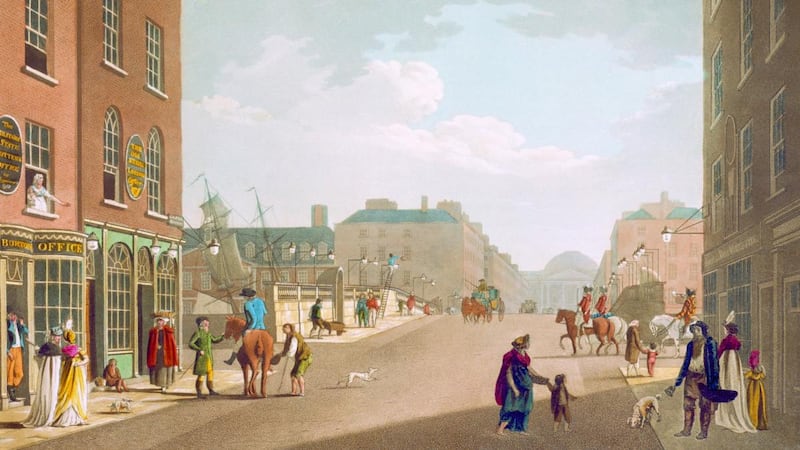
In the late 1770s the quirky agricultural tourist Arthur Young reported on his visits to Ireland. “The towns of Ireland,” he observed, “have very much increased in the last 20 years.” This, for Young, could only be a positive development since urban growth was a mark of rising prosperity, bringing riches and employment. It is that remarkable flourishing of urban Ireland between 1660 and 1820 that is the subject of David Dickson’s book.
Irish historians have never experienced the torrid love affair with towns that historians in other countries have. It may be that for an older generation the Irish experience was predominately a rural one. After all, towns were usually the products of invasions – Vikings in Dublin and Waterford, Normans at Galway and Kilkenny and 17th-century planters in Belfast and Derry.
That did not prevent 19th-century antiquarians paying tribute to their own places: George Benn for Belfast, James Hardiman for Galway and JT Gilbert for Dublin, for example. Good as these studies were, they tackled particular places in isolation, and it is difficult to assess the significance of the nuggets they uncovered.
More recent urban history has stressed the importance of the town as a clearing ground for all aspects of life, which encouraged studies that embrace as wide a span of past human endeavour as possible; to examine urban cultures rather than towns. Also significant is the comparative approach that tries to separate the general features of the urban experience from the particular and the local.
These ideas inform David Dickson’s approach to Irish urban history. The strength of this book is that it is not a study of one town but of 10 – Waterford, Belfast, Cork, Dublin, Kilkenny, Derry, Limerick, Sligo, Galway and Drogheda – and that a wide range, though not all, of human life is encompassed within its pages.
Religion and education
Starting with the changing topography of the selected towns, it expands to the people in those landscapes and the primacy of trade in the shaping of urban life. Yet, what divided people was often as powerful as what united them. Thus, religion, together with the allied question of education, receives its fair share of discussion though in a rather institutional context that doesn’t come to terms with religion as a cultural or social phenomenon.
Still, the life of the mind is represented in a chapter on the print trades, and for those preferring more political activity there are chapters on riots and the violent politics of the 1790s. David Dickson never allows his story to be reduced to trends or social processes or statistical abstracts. The real voices of the 18th-century town, including the poor, are carefully extracted from a surprisingly wide range of sources to reveal much of the textures of everyday life.

Within these broad themes, comparisons between towns help to frame patterns of regional urban culture. Inevitably this exercise is not as rewarding as we would hope. Variations in the quality and quantity of surviving evidence means that conclusions must be provisional. Nevertheless, such approaches go a long way towards answering the old chestnut of whether Belfast really was as different from the rest of urban Ireland as has often been asserted. Was it in some ways similar to Kilkenny but “much more of a colonial town”?
The imprint of the 17th-century settlement struck deep into urban Ireland, helping to shape a set of regional cultures. Yet what stands out in this volume is the sheer dominance and atypical nature of Dublin. The second city of the 18th-century British empire was an enigma not just to contemporaries but also to later observers. The institutional and cultural influence of the city was spectacular. Not even London could rival the combination of a university, courts of law, centre of government, mercantile wealth and ecclesiastical power house along with the intellectual stimulation of learned societies all in one place.
Flourishing Dublin
When it came to reshaping the city in the 18th century, no other Irish town could compare with the juxtaposition of government, merchant and land developer in Dublin. Even Limerick’s brave attempt in Perry Square pales beside it.
Still, contemporaries could not resist comparing themselves with London, grumbling of a cultural subjection to match the political one imposed after 1720. Some strove for innovation and novelty. While merchants dominate this book, musicians fail to enter the lists. Yet the flourishing of music, and the associated conviviality, was one of the triumphs of 18th-century Dublin. Newspaper evidence suggests that in both Cork and Belfast music also played a significant part in urban life. Here is surely a whole world awaiting discovery and mapping. While we will probably never know much about tavern life in 18th-century Ireland beyond occasional glimpses, there is much to be known about other forms of sociability as clubs and societies mushroomed, promoted by those determined to demonstrate their civility to a wider world.
This is a book that operates on a number of levels. For some readers the pleasure will be in excavating nuggets of information on particular places – and thanks to Dickson’s mastery of the evidence there are many gems to be discovered. For others the thrill will be in the comparisons that reveal what is unique about one town and what characteristics it shared with other places.
The chapter on the manifestation of the crisis of the 1790s in the various towns is a masterclass in this sort of exercise. The nature of Belfast society was such that the radicalism manufactured there could not be found in Dublin or Cork, which produced their own brand of disorder. For other readers the fun will be in following Arthur Young’s insights and using the fortunes of towns as an index to the grand sweep of the 18th century. Whichever category you fall into, you will find enlightenment and entertainment in this volume.
Raymond Gillespie teaches in Maynooth University and is an editor of the Irish Historic Towns Atlas series in the Royal Irish Academy















